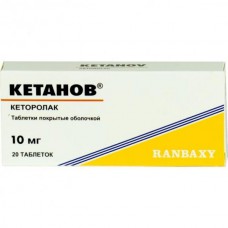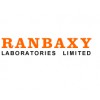Expiration date: 12/2025
The composition and form of issue:
Tablets, film-coated, 1 tablet contains:
Ketorolac 10 mg trometamina
excipients: corn starch, microcrystalline silicon dioxide colloidal magnesium stearate
film shell: hydroxypropyl methylcellulose polyethylene glycol 400 (macrogol 400) talc purified titanium dioxide purified water (lost in the production process)
blistere in 10 PCs. in cardboard pack 1, 2, 3, or 10 blisters.
Solution for intramuscular injection, 1 ml contains:
Ketorolac 30 mg trometamina
excipients: sodium chloride disodium edetate ethanol sodium hydroxide water for injections
in 1 ml ampoules in cartons of 5 or 10 PCs.
Description pharmaceutical form:
Tablets: round, biconvex, film-coated white or almost white, engraved with "KVT" on one side.
Solution for injection: clear, colorless or pale yellow solution.
Pharmacokinetics:
After intake, caution is well absorbed in the digestive tract — Cmax in plasma (0, 7-1, 1 µg/ml) is achieved after 40 min after administration on an empty stomach dose of 10 mg. fat-Rich food reduces the Cmax of the drug in blood and detains her achievement on 1 hour 99% of drug binds to blood plasma proteins and hypoalbuminemia when the amount of free substances in the blood increases. Bioavailability of 80-100%.
Absorption in the/m introduction — full and quick. After the/m of the reference 30 mg drug Cmax is 1, 74-3, 1 µg/ml, 60 mg — 3, 23– 5, 77 µg/ml, Tmax respectively 15-73 and 30-60 min.
The time to reach equilibrium concentration (CSS) for parenteral and oral administration — 24 hours at the destination 4 times a day (subtherapeutic above) is when the/m introduction in doses of 15 mg — 0, 65-1, 13 µg/ml, 30 mg — 1, 29-2, 47 mcg/ml after ingestion of 10 mg — 0, 39-0, 79 µg/ml. the Volume of distribution is 0, 15-0, 33 l/kg in patients with renal insufficiency the volume of distribution of drug can be increased in 2 times, and its R-enantiomer — on 20%.
Enters breast milk: after taking a mother first and a second dose of Ketorolac (10 mg) Cmax in milk is achieved after 2 h and are respectively 7, 3 and 7, 9 ng/L.
More than 50% of the administered dose is metabolized in the liver to form pharmacologically inactive metabolites. The main metabolites are the glucuronide, which is excreted by the kidneys, and R-hydroxyketones. Displays 91% in the kidneys, 6% — through the intestines.
T1/2 in patients with normal renal function is an average of 5, 3 h (3, 5-9, 2 h after the/m introduction 30 mg, and 2, 4-9 h after ingestion of 10 mg). T1/2 longer in elderly patients and shortened young. Liver function does not affect T1/2. In patients with impaired renal function with creatinine concentration in the blood plasma 19-50 mg/l (168-442 µmol/l) T1/2 is 10, 3-10, 8 h, with more pronounced renal failure — more 13, 6 PM
Total clearance is when I/m administration at a dose of 30 mg 0, 023 l/kg/h (0, 019 l/kg/h in older patients), administered at a dose of 10 mg — 0, 025 l/kg/h in patients with renal insufficiency with creatinine concentration in the blood plasma 19-50 mg/l in in/m administration at a dose of 30 mg — 0, 015 l/kg/h, the ingestion of 10 mg — 0, 016 l/kg/h.
Not displayed during hemodialysis.
Description of the pharmacological action:
Ketorolac has a marked analgesic effect, also has anti-inflammatory and mild antipyretic action.
The mechanism of action is nonselective inhibition of the activity of the enzyme COX-1 and -2 mainly in peripheral tissues, resulting in the inhibition of the biosynthesis of PG — modulators of pain sensitivity, thermoregulation and inflammation. Ketorolac is a racemic mixture of [-]S - and [+]R-enantiomers, while the analgesic effect is due to [-]S form.
The drug does not affect opioid receptors, not oppressing breathing, does not cause drug dependence, does not possess sedative and anxiolytic effect.
Strength of the analgesic effect comparable to morphine, significantly superior to other NSAIDs.
After the/m introduction and admission into the beginning of the analgesic action is noted respectively in 0, 5 and 1 h, the maximum effect is achieved in 1-2 hours
Indications:
Syndrome pain of moderate to severe intensity of different Genesis ( including in the postoperative period, in Oncology).
Contraindications:
- hypersensitivity to Ketorolac or other NSAIDs, "aspirin asthma", bronchospasm, angioedema, hypovolemia (whatever the causes that caused it), dehydration
- erosivno-azwenne shock syndrome in acute phase, peptic ulcer, anticoagulation ( including hemophilia)
- hepatic and/or renal failure (plasma creatinine above 50 mg/l)
- haemorrhagic stroke (confirmed or suspected), bleeding diathesis, concomitant use with other NSAIDs, high risk of development or recurrence of bleeding (including after surgery), impaired hematopoiesis
- pregnancy, childbirth and lactation
- children up to age 16 years (effectiveness and safety have not been established)
- anesthesia before and during surgery (because of the high risk of bleeding)
- the treatment of chronic pain.
Caution with bronchial asthma, cholecystitis, chronic heart failure, arterial hypertension, impaired renal function (plasma creatinine below 50 mg/l), cholestasis, active hepatitis, sepsis, systemic lupus erythematosus elderly age (over 65 years) the polyps of mucous membrane of nose and nasopharynx.
Side effect:
The incidence of side effects is defined as follows: frequently — more than 3% less often 1-3% rarely — less than 1%.
From the digestive system: often (especially in elderly patients older than 65 years with a history of erosive-ulcerative lesions of the gastrointestinal tract) — gastralgia, diarrhea, less often — stomatitis, flatulence, constipation, vomiting, feeling of fullness of the stomach rarely, nausea, erosive-ulcerative lesions of the gastrointestinal tract (including with perforation and/or bleeding — abdominal pain, spasm or burning sensation in the epigastrium, melena, vomiting type "coffee grounds", nausea, heartburn, etc.), cholestatic jaundice, hepatitis, hepatomegaly, acute pancreatitis.
From the urinary system: rarely — acute renal failure, back pain with or without hematuria and/or azotemii, hemolytic uremic syndrome (hemolytic anemia, renal failure, thrombocytopenia, purpura), frequent urination, increase or decrease the volume of urine, nephritis, edema of renal origin.
From the sensory organs: rarely — hearing loss, ringing in the ears, visual disturbances (including blurring of visual perception).
The respiratory system: rarely bronchospasm or dyspnoea, rhinitis, laryngeal edema (shortness of breath, difficulty breathing).
CNS: frequently — headache, dizziness, drowsiness, rarely — aseptic meningitis (fever, severe headache, convulsions, rigidity of the muscles of the neck and/or back), hyperactivity (change in mood, anxiety), hallucinations, depression, psychosis.
From the side of cardiovascular system: less often — increased blood pressure rare — pulmonary edema, syncope.
Organs of hematopoiesis: rarely — anemia, eosinophilia, leukopenia.
From the hemostatic system: rarely — bleeding from the postoperative wound, nasal bleeding, rectal bleeding.
With the skin: less often — skin rash (including maculopapular rash), purpura rare — exfoliative dermatitis (fever with or without chills, redness, induration, or skin peeling, swelling and/or soreness of the tonsils), urticaria, Stevens-Johnson syndrome, Lyell's syndrome.
Local reactions: less often — burning or pain at the injection site.
Allergic reactions: rare — anaphylaxis or anaphylactoid reaction (discoloration of the skin, skin rash, hives, itching of the skin, tachypnea or dyspnea, swelling of the eyelids, periorbital swelling, wheezing, shortness of breath, heaviness in chest, wheezing).
Other: often — swelling (face, legs, ankles, fingers, feet, increased body mass) less often, excessive sweating is rarely tongue swelling, fever.
Drug interaction:
The simultaneous use of Ketorolac with acetylsalicylic acid or other NSAIDs, calcium supplements, corticosteroids, ethanol, corticotropin may lead to ulceration of the gastrointestinal tract and the development of gastrointestinal bleeding.
Joint appointment with paracetamol increases nefrotoksicnosti, with methotrexate — gepato - and nefrotoksicnosti. Combined prescription of Ketorolac and methotrexate is only possible when using low doses of the latter (to control the concentration of methotrexate in plasma).
The probenecid decreases plasma clearance and volume of distribution of Ketorolac, increases its concentration in blood plasma and increases the period of its half-life. On the background of the use of Ketorolac may decrease clearance of methotrexate and lithium and increased toxicity of these substances. Joint appointment with indirect antikoagulyantami, heparin with thrombolytic drugs, antiplatelet agents, cefoperazone, and cefotetan with pentoxifylline increases the risk of bleeding. Reduces the effect of antihypertensive and diuretic drugs (decreases synthesis of GHGs in the kidneys). When combined with opioid, analgetikami the dose of the latter can be significantly reduced.
Antacids means do not affect the completeness of absorption of medicine.
Increased hypoglycemic effect of insulin and oral hypoglycemic drugs (requires the recalculation of doses).
Joint appointment with valproate sodium causes a disturbance of platelet aggregation. Increases concentration in plasma of verapamil and nifedipine.
While administration with other nephrotoxic drugs (including drugs with gold) increased risk of nephrotoxicity. Drugs that block tubular secretion, reduce the clearance of Ketorolac and increase its concentration in the blood plasma.
The solution for injection should not be mixed in the same syringe with morphine sulfate, prometazinom and hidroxizina due to sedimentation. Farmatsevticeski incompatible with the solution of tramadol, drugs lithium.
The solution for injection is compatible with normal saline, 5% dextrose solution, ringer solution and ringer-lactate solution "Plasmalite", as well as with infusion solutions, containing aminophylline, lidocaine hydrochloride, dopamine hydrochloride, human insulin short-acting and heparin sodium salt.
Method of application and doses:
Tablets. Inside, once or repeatedly, depending on the severity of the pain syndrome. A single dose of 10 mg, if re-admission is recommended to take 10 mg up to 4 times a day depending on the severity of the pain the maximum daily dose should not exceed 40 mg.
At intake duration of the course shall not exceed 5 days.
The solution for injection. In/m (deep), in minimally effective doses, selected in accordance with the intensity of pain and response of the patient. If necessary, at the same time you can optionally assign opioid analgesics in small doses.
Single doses with a single on/m introduction:
- patients up to 65 years — 10-30 mg depending on the severity of pain syndrome
- patients older than 65 years or with impaired renal function — on 10-15 mg.
Dose repeated when in/m introduction:
- patients up to 65 years — 10-30 mg, then — on 10-30 mg every 4-6 hours
- patients older than 65 years or with impaired renal function — on 10-15 mg every 4-6 h
The maximum daily dose of intramuscular injection for patients under 65 years should not exceed 90 mg, and for patients older than 65 years or with impaired renal function — 60 mg.
For parenteral administration, the duration of treatment should not exceed 5 days.
When switching from parenteral administration of the drug to the ingestion of the total daily dose of both medicinal forms in day of transfer should not exceed 90 mg for patients till 65 years and 60 mg for patients older than 65 years or with impaired renal function. The dose of the drug in tablets on the day of transfer should not exceed 30 mg.
Overdose:
Symptoms: abdominal pain, nausea, vomiting, the appearance of peptic gastric ulcers or erosive gastritis, violation of function of kidneys, metabolic acidosis.
Treatment: gastric lavage, introduction of adsorbents (activated carbon) and symptomatic therapy (maintenance of vital functions in the body). Not excreted sufficiently by dialysis.
Special instruction:
Influence on platelet aggregation is terminated 24-48 hours.
Hypovolemia increases the risk of adverse reactions in the kidneys. If necessary, you can assign in combination with narcotic analgesics.
Ketanov is not recommended as a means for sedation support anesthesia and analgesia in obstetric practice.
Do not use simultaneously with paracetamol more than 5 days. Patients with impaired blood clotting drug administered only under constant control the number of platelets, which is especially important during the postoperative period, when required, careful control of hemostasis.
Because a significant proportion of patients in the appointment Ketanov develop side effects from the CNS (drowsiness, dizziness, headache), it is recommended to avoid jobs that require attention and fast reactions (driving vehicles, work with mechanisms, etc.).




